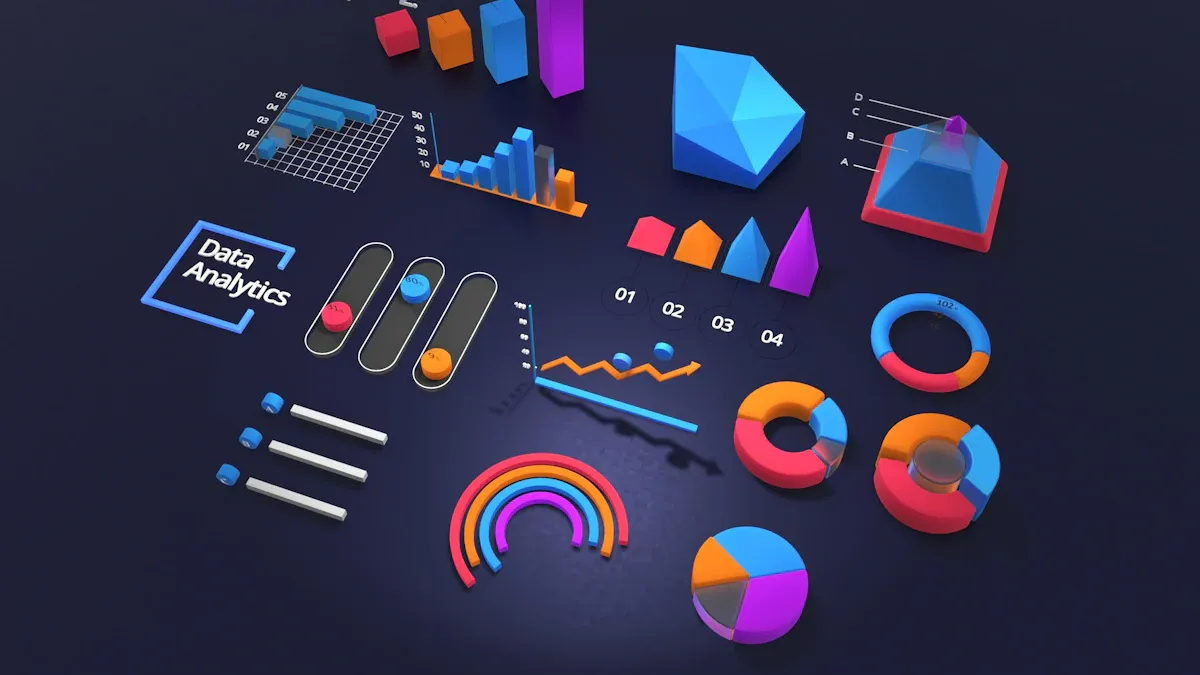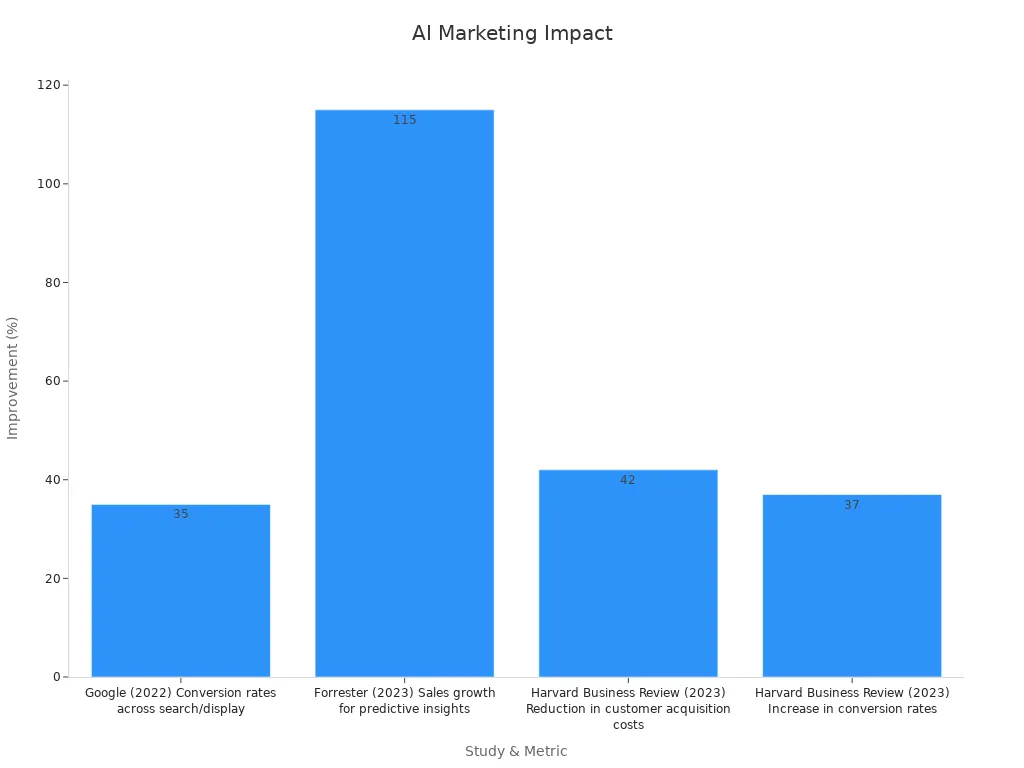How AI Helps Target Ultra-Specific Demographics

AI helps target specific groups by studying lots of data. It spots patterns and behaviors to assist businesses. You can use AI to find small, unique audiences easily. For example, 82% of companies now use AI tools for marketing. These tools provide 71% of people with the personal experiences they desire. They also generate five to eight times more revenue than traditional methods. AI helps connect with people in better ways, preventing the frustration that 76% of customers feel when brands aren't personal enough.
Key Takeaways
AI helps companies find and reach specific customer groups. This improves ads and increases sales.
Knowing detailed customer groups helps create messages they like. This builds trust and keeps customers loyal.
Machine learning finds patterns in customer data fast. This makes targeting easier and more accurate.
Real-time data analysis keeps ads flexible. It lets companies react quickly to trends and customer actions.
AI saves money on marketing by automating tasks. It works faster and gives better results for the money spent.
Understanding Ultra-Specific Demographics
Defining Ultra-Specific Demographics
Ultra-specific demographics are small, detailed groups of people. These groups are based on unique traits, actions, or likes. They go beyond simple things like age or gender. Instead, they focus on specific interests, shopping habits, or ways people like to communicate. For example, instead of targeting "millennials," you could focus on "millennials who love eco-friendly travel and buy green products."
By narrowing your audience, you learn more about their needs. This helps you create messages that feel personal and important to them. It also saves time and money by not targeting people who won’t care about your brand. Ultra-specific demographics let you connect with people in a meaningful way.
Importance of Ultra-Specific Demographics in Marketing
Focusing on ultra-specific demographics can improve your marketing. When you know your audience’s unique traits, your campaigns can match their needs. This leads to better results, more sales, and loyal customers.
Here’s how ultra-specific demographics help marketing:
Key Points | Description |
|---|---|
Better Marketing Results | Custom strategies meet specific needs, boosting customer interest. |
Focused Product Creation | Products can be made for small groups, like gadgets for young users. |
Marketing efforts reach the right people, saving time and money. |
For example, if your audience cares about the environment, show off your eco-friendly products. This attracts the right buyers and builds trust. By focusing on ultra-specific groups, your marketing matches what people really want.
Tip: Start by studying your current customers. Look for patterns in what they do, like, or say to find smaller groups to target.
How AI Helps Target Ultra-Specific Demographics

Machine Learning for Audience Segmentation
Machine learning helps find very specific groups of people. It looks at a lot of data quickly and finds patterns. These patterns are often missed by older methods. By studying customer data, machine learning creates smaller, useful groups. These groups share things like shopping habits or interests.
For example, machine learning can figure out how many groups exist in your data. This makes audience segmentation more accurate. Unlike doing it by hand, which takes time, machine learning is faster and better. It also shows hidden details about your audience, helping you know them better.
How AI Helps Target ultra-specific demographics with machine learning:
It studies social media data like age and location.
It finds patterns in browsing or buying habits.
It improves targeting by creating strategies for specific groups.
Case Study: A clothing company used machine learning to make ads personal. They studied customer data and saw a 60% rise in sales. They also cut costs by 40%. This shows how machine learning can improve marketing.
Natural Language Processing for Behavioral Insights
Natural language processing (NLP) helps you learn how people think. It looks at text from social media, reviews, and searches. NLP finds important details about what customers like and how they feel.
For example, NLP can study reviews to find trends that affect buying. It can also check social media comments to see how customers feel right now. These details help you change your messages to match what people want.
Industry | Example of NLP Application | Insights Gained |
|---|---|---|
E-commerce | Studying search terms, past buys, and reviews | Better recommendations based on behavior, increasing sales and happiness. |
Retail | Checking reviews and social media mentions | Spotting trends to manage inventory and improve marketing. |
Marketing | Learning customer feelings to improve messages and campaigns. |
Using NLP helps you understand your audience better. This lets you create personal experiences that build trust.
Real-Time Data Analysis for Dynamic Targeting
Real-time data analysis helps you change your marketing fast. It looks at live data from websites, social media, and purchases. This keeps your campaigns updated and useful.
For example, real-time analysis can spot trends as they happen. If a product becomes popular, you can quickly promote it. This boosts sales and keeps people interested. Real-time data also tracks customer actions, so you can improve your targeting.
Application Phase | Description |
|---|---|
Pre-Authorization | Finds groups with unmet needs and checks health risks. |
Post-Authorization | Confirms safety details and tracks side effects over time. |
Insights Management | Combines real-world data to help with drug development and trials. |
Real-time data analysis keeps your marketing flexible. It helps you react to changes, making your campaigns work better.
Benefits of AI in Targeting Ultra-Specific Demographics
Precision in Audience Targeting
AI helps you find the right people for your ads. It studies large amounts of data to spot groups based on what they like or do. This lets you create messages that fit their needs. Instead of guessing, AI makes sure your message reaches the right audience.
For example, AI finds patterns that older methods often miss. It creates messages that match what people enjoy, making them more interested. It also helps you focus your time and money on the right groups. These changes lead to better results and more sales.
Metric | Description |
|---|---|
AI finds smaller, accurate groups for better targeting. | |
Improved Personalization | Messages match what people like, boosting interest. |
Higher Efficiency | Campaigns use resources wisely, saving time and money. |
More Conversions | AI strategies make people more likely to buy or act. |
Using AI makes your campaigns more accurate and effective. This helps you connect with people in ways that matter.
Cost-Effectiveness in Marketing Campaigns
AI helps you save money while improving your ads. It automates tasks like finding audiences, placing ads, and tracking results. This saves time and reduces the need for extra work. Your campaigns become cheaper and more effective.
Studies show that businesses using AI save a lot of money. For example, Deloitte found that companies using AI for leads saved 20% on costs and got 15% more sales. McKinsey reported that AI can make operations 30% more efficient. These numbers show how AI helps you get more from your budget.
Source | Findings |
|---|---|
Deloitte | AI-based lead generation saves 20% on costs and boosts sales by 15%. |
McKinsey | AI improves efficiency by up to 30% in operations. |
Accenture | 84% of executives believe AI gives them a competitive edge. |
AI reduces waste and makes your spending smarter. This helps you reach your goals without spending too much.
Enhanced Customer Engagement and Personalization
AI helps you make customers feel special and stay interested. It looks at data like social media, shopping history, and online actions. This helps you offer products, services, or content that fit each person perfectly.
For example, AI can suggest items based on what someone bought before. It can also recommend videos or articles they might like. This makes customers feel understood and builds trust. Happy customers are more likely to return and share good reviews.
AI can also act quickly when customers do something. If someone leaves items in their cart, AI can send a reminder or discount. These small actions show customers you care and keep them coming back.
Tip: Use AI to study customer feedback and improve your plans. This keeps your campaigns fresh and useful.
By making experiences personal, AI helps you build strong relationships. These connections lead to loyal customers and long-term success.
Real-World Applications of AI in Demographic Targeting

E-Commerce and Personalized Shopping
AI makes online shopping feel more personal and fun. It learns what you like, how you shop, and what you buy. Then, it suggests items just for you. For example, AI changes online stores to match your interests. This makes shopping easier and more exciting. It also helps you find products faster by understanding your searches.
If you leave items in your cart, AI sends reminders or discounts. It also suggests items that go well with what you’ve bought. This makes shopping more enjoyable. AI even shows similar products, giving you more choices. It encourages you to try better or more expensive items too.
Application Area | Description |
|---|---|
Personalized Storefronts | |
Enhanced Search Journeys | AI helps you find items faster by understanding your searches. |
Improved Cart Conversions | AI reminds you about items left in your cart with offers. |
Complementary Recommendations | AI suggests items that match what you’ve already bought. |
Similar Product Recommendations | AI shows you similar items, giving you more options. |
Cross-Selling and Upselling | AI suggests better or pricier items to improve your shopping. |
Healthcare and Patient-Centric Campaigns
AI is changing healthcare by focusing on patients’ needs. It studies patient data to suggest health tips or programs. For example, AI can recommend exercises or diets based on your health history. It also helps doctors predict health problems early, so they can offer better care.
AI makes talking to doctors easier too. Chatbots can answer your questions or help you book appointments. By creating health plans just for you, AI ensures you get the right advice and support.
Entertainment and Content Personalization
AI makes entertainment more fun by giving you content you’ll love. Streaming apps use AI to learn what you watch and suggest shows or movies. This keeps you watching longer and makes you more likely to subscribe.
AI also helps creators make content faster and cheaper. It focuses on what people enjoy, which boosts engagement. Whether it’s music, videos, or articles, AI ensures the content matches your interests.
Subscriptions increase by 45%.
Content creation is 40% faster.
Costs drop by 35%.
Engagement improves by 28%.
AI makes entertainment more exciting and keeps you coming back for more.
Challenges and Ethical Considerations
Addressing Data Privacy Concerns
AI studies a lot of personal data, which can cause privacy worries. Sometimes, AI collects data without asking for permission. Biometric data, like fingerprints or face scans, is risky because it can't be changed if stolen. Secret data collection methods also confuse users, who may not know how their data is being used.
To solve these problems, follow these steps:
Do a full AI risk check: Find all AI systems and rank their risks. Write down dangers and follow rules.
Use strong data controls: Only collect needed data and protect it with encryption.
Design privacy into AI systems: Add privacy features early and explain data use to users clearly.
Monitor systems often: Look for problems and check systems regularly to stay compliant.
Create a team to manage AI: Include experts from law, tech, and business to guide AI use.
These actions help keep user data safe and ensure AI is used responsibly.
Mitigating Bias in AI Algorithms
AI can sometimes treat certain groups unfairly. This happens when training data or algorithms are not diverse enough. For example, targeting groups might ignore minorities if the data is incomplete.
Studies suggest ways to fix bias:
Title | Description |
|---|---|
Fixing bias in AI predictions for minority groups | Shows methods like adjusting data before, during, or after AI processes. |
Finding and fixing algorithm bias: Tips and rules | Offers steps to spot bias and make AI fair through better policies and practices. |
Use these ideas to make sure AI treats everyone equally. Check algorithms often and use diverse data to reduce bias.
Balancing Personalization with Consumer Trust
Personalized ads can make customers happy but also worry them about data safety. Many people fear how companies collect and use their information. Surveys show 87% avoid brands they don't trust, and 82% worry about data collection.
To build trust, be open about your data practices. Tell customers how their data is used and protect it with strong security. Privacy-by-design methods can help create safe systems. When people feel their data is secure, they enjoy personalized experiences more.
Note: Balancing personalization and privacy means being honest and ethical. Solving concerns early builds trust and keeps customers loyal.
AI changes how businesses reach specific groups of people. It studies large amounts of data to create better marketing plans. Research shows how AI improves marketing results. For example:
Study Source | Metric | Improvement Percentage |
|---|---|---|
Google (2022) | Better conversion rates for ads | 35% |
Forrester (2023) | Sales growth using smart predictions | 115% |
Harvard Business Review (2023) | Lower costs to get new customers | 42% |
Harvard Business Review (2023) | Higher conversion rates | 37% |

AI has challenges like privacy and fairness issues. Using ethical AI can solve these problems. By using AI tools, businesses can stay ahead and give customers personal experiences they enjoy.
FAQ
What is the main advantage of using AI for demographic targeting?
AI studies data fast and finds useful patterns. It creates small, accurate groups for better marketing. This saves time, lowers costs, and improves results.
How does AI ensure personalization in marketing?
AI looks at what customers like and do. It uses this data to make ads, messages, or suggestions that fit them. This makes people feel special and keeps them interested.
Tip: Use AI to study customer reviews for better ideas.
Is AI-based targeting suitable for small businesses?
Yes! AI tools work for all business sizes. They help small businesses find unique groups without spending too much. This makes marketing more effective.
How does AI handle real-time data for marketing?
AI checks live data from websites and social media. It changes ads quickly based on trends or actions. This keeps your marketing fresh and useful.
Are there ethical concerns with AI in demographic targeting?
Yes, issues include privacy and unfair treatment. To fix this, use clear rules, check AI often, and include diverse data. Ethical AI builds trust and keeps customers safe.
Note: Always explain how you collect and use customer data.
See Also
Steps To Discover Your Startup's Ideal Customer Base
Creating Blog Posts That Cater To Your Target Audience
Using TikTok Analytics To Boost Audience Interaction Effectively
Analyzing Competitor Content To Gain A Competitive Edge
Writesonic AI And QuickCreator: The Ultimate Content Showdown

